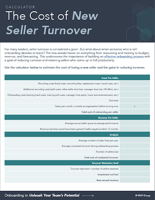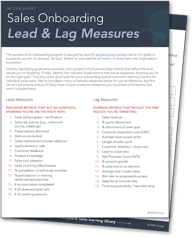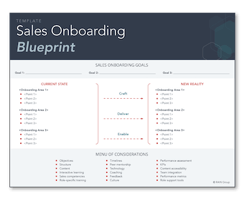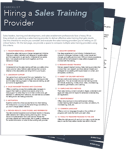Recruiting and hiring strong sales talent isn't for the faint of heart.
It is, in fact, the top challenge facing sales and enablement leaders (cited as “very challenging” by 52%). It's not only challenging, but also takes a significant investment of resources to find, hire, and retain talent.
This is why it’s not difficult to see the value of a highly effective sales onboarding program—to make the most of that investment. In fact, organizations with the most effective onboarding are 4x more likely to get new hires to productive selling under 3 months.
But just how do you do it?
In this article, you’ll learn how your organization can build a highly effective onboarding program for your new sales hires, supported by onboarding insights from the RAIN Group Center for Sales Research.
A Step-By-Step Guide to Sales Hire Onboarding
What Is the Sales Onboarding Process?
The goal of the sales onboarding process is to prepare sellers to succeed. Extremely or very effective sales onboarding programs do just that. Organizations with effective onboarding are 6.3x more likely to prepare their new sales hires to succeed, according to RAIN Group research.
Our Onboarding Process Prepares New Sales Hires to Succeed
% Strongly Agree
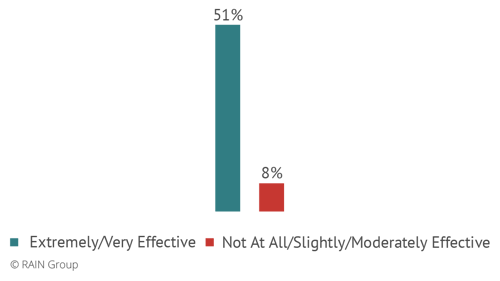
Unfortunately, only 35% of survey respondents overall rate their company’s sales onboarding as extremely or very effective.
Our research also shows that the process for onboarding new sales hires and getting sellers to full productivity is strongly correlated to key measures of a well-functioning sales organization.
When a company’s onboarding process is effective:
- Sales managers are more than twice as likely to be effective at getting maximum performance from their sellers (49% vs. 23% when onboarding isn't effective).
- Sellers are 4x more likely to be productive in less than 3 months.
- Top sales talent is retained. Average turnover decreases from 50% to 12% as onboarding effectiveness increases.
Average Turnover Rates by Sales Onboarding Effectiveness
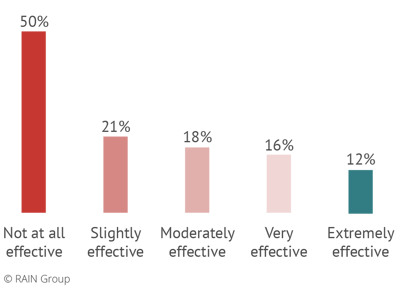
What Does Effective Onboarding Look Like?
Characteristics of Onboarding by Program Effectiveness
% Strongly Agree
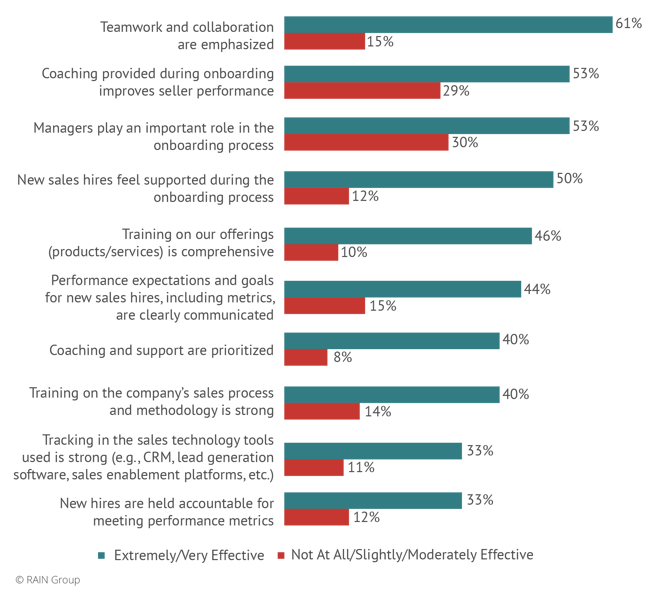
A few common themes emerge when we look at the characteristics of the most effective onboarding programs.
- Training: Training on offerings, sales process and methodology, and sales technology is comprehensive and allows new hires to seamlessly step into their roles.
- Support: New sales hires need to feel supported, both by their colleagues and their managers.
- Teamwork: New sales hires should be working with their teams and collaborating from the onset, fully immersed in projects, workflows, etc. Managers should be supporting them both in their roles and throughout the onboarding process.
- Coaching: Onboarding isn’t a “set it and forget it” program. Managers and coaches should be involved throughout the process with regular touchpoints with new sales hires. This includes clearly communicated expectations for what they should be doing, and then being held accountable for doing it.
But, where to begin?
One important area is often missing: providing strong training on the sales process and methodology, which we found is the #1 key driver of effective sales onboarding1.
It turns out that:
- 51% of sales organizations don’t have a defined sales process
- 77% of respondents don’t highly rate sales process and methodology training
And, as we’ve seen throughout our research, this also impacts revenue as companies with no consistent sales process have a lower average proposal win rate.
Providing effective training on your sales process and methodology is a good place to start.
3 Steps for Building an Effective Seller Onboarding Process
Use these three actions—the building blocks for any effective sales training initiative—to build a highly effective seller onboarding process.
- Craft: Identify the business metrics you want to drive and then develop a strategy to get there. In this step, you establish the vision for your onboarding process – what’s included in onboarding, what skills are needed, what support will be offered, etc.
- Deliver: Today’s sellers need and expect hands-on training that’s practical, interactive, and impactful. You need to deliver structured onboarding that holds sellers accountable, is focused on application, and includes regular feedback, support, and coaching.
- Enable: In this step you empower sellers to execute at high levels, getting them to full productivity. Ongoing measurement allows for results to be tracked and helps identify areas for continuous improvement—or "everboarding".
When you use this process to implement an onboarding program tailored to your organization’s sales team, you’ll get the most from your investment in new hires, retain the best sellers, and boost sales results.
Learn more about building effective sales training. >>
1. Craft the Onboarding: Vision, Metrics, and Strategy
To develop an effective onboarding process, you need to start by establishing the vision, business metrics, and strategy.
The Cost of Seller Turnover
It’s helpful to begin by quantifying what’s at stake for each new hire retained or lost. This will help you make assumptions about how increases in onboarding effectiveness can lower unwanted turnover and give you a basis for knowing how much to invest to make the improvements worthwhile.
Seller turnover is a significant concern for businesses, and its financial implications are often underestimated. While estimated turnover costs range from 100% to 500% of a seller's compensation, this often doesn't factor in the potential revenue lost when a seller leaves the organization.
Consider the investment a company makes in new sellers. Before these sellers become productive, they represent a cost. On average, a company might spend hundreds of thousands of dollars over several quarters for each new seller. When you scale that up to 10 sellers, the investment quickly jumps into the millions.
By refining the onboarding process, businesses can not only reduce turnover but also cut down recruitment expenses and boost revenue.
Let’s break it down in a hypothetical situation:
The average total cost per sales rep, encompassing recruitment, onboarding, and salary, stands at $152,330.
With a 40% turnover rate during onboarding, a company could lose 4 out of every 10 new hires each year.
This translates to an annual turnover cost of $609,320. Add to that a potential loss of $1 million in revenue for each departing seller.
The silver lining? By retaining just two more sellers annually, a company could save $304,660 and rake in an extra $4 million in revenue.
Match Performance Metrics to the Training Goals
The success of the onboarding program is gauged by specific performance metrics tied to the goals or outcomes you aim to achieve. As such, there's no one-size-fits-all metric; it varies from one organization to another.
Start by identifying goals and outcomes, then pinpoint the business (lag) metrics that reflect the end results you're targeting. Finally, identify the indicator (lead) metrics that act as signposts, showing you're on the right path.
This should be done both for your onboarding overall and when defining metrics for individual sales roles. For example, a lag onboarding measure may be time for a new seller to be ready to interact with buyers, and lead measures may be number of observed sales calls, percent completion of self-study modules, and number of coaching sessions.
With a clear understanding of these metrics, you can then craft a strategy tailored to meet and even surpass them.
Action Step
Determine lead and lag measures for onboarding success. Use the Sales Onboarding Lead and Lag Measures Worksheet in the Sales Onboarding Toolkit. →
Set the Onboarding Strategy
Next, determine the roadmap—how you’re going to achieve these metrics.
Involve executive sponsors, key stakeholders, and the training team to craft the strategy. Together, carve out a clear vision and set expectations for everyone involved: sales reps, sales managers and coaches, L&D, the sales enablement team, leaders, and so on.
As you build the onboarding process, focus on how you’ll incorporate these four key drivers, which the research indicates are predictive of effective sales onboarding:
- Training on the company’s sales process and methodology is strong
- New sales hires feel supported during the onboarding process
- Teamwork and collaboration are emphasized
- Coaching and support are prioritized
Predicting Success
Research on Onboarding New Sales Hires by the RAIN Group Center for Sales Research identifies the above as 4 key drivers of effective onboarding.
That #1 item, training on the company’s sales process and methodology, is often overlooked, yet it’s a top predictor of effective onboarding. Ensure training on your sales process and method is addressed in onboarding.
Clearly, managers play a pivotal role in effective seller onboarding, not only by reinforcing the sales process and method, but also by:
- Helping sellers feel supported OR ignored
- Reinforcing a culture of teamwork and collaboration in their sales meetings OR maintaining silos
- Prioritizing a regular schedule of coaching OR leaving sellers to their own devices
Which direction your sales managers take will have a long-term impact on the success of the sales team.
Research shows that sellers with less than 5 years’ experience are 240% more likely to be Top Performers when they have an effective manager.
We suggest sketching out a blueprint; an image will help you and your team visualize where things stand at the outset (the current state) and the new reality you aim to achieve from the onboarding initiative.
Start with where the onboarding process is currently, whether it’s an existing process you’re looking to improve or a new process you’re building. Then, identify what success looks like.
As you found when you quantified the cost of losing new hires during onboarding, the stakes are high. Improving seller retention can boost sales performance that translates to gains in the millions. It can drive growth, enhance competitiveness, and influence stock prices—all of which usually sit at the top of leadership agendas.
Understanding your present situation and visualizing your desired future (the “New Reality”) helps you to chart a course to success.
Action Step
Download and complete the Sales Onboarding Blueprint contained in the Sales Onboarding Toolkit. →
Onboard with a Skills Framework
Next, identify what your new sales hires need to accomplish and produce, then you can identify the essential knowledge, skills, and behaviors that will help them succeed. Once defined, it becomes easier to determine the content and structure of the onboarding.
A competency model or skills framework helps you understand the skills sellers need and provides a foundation for building the curriculum and learning journey. Use our Top-Performing Seller model or the competency model used in your organization.
The Top-Performing Seller ModelSM
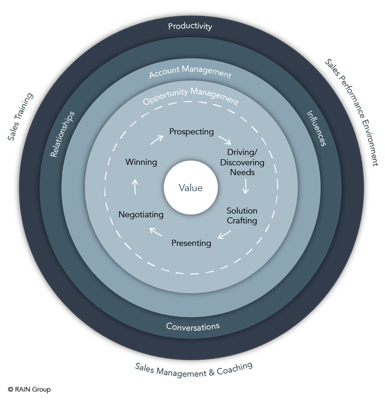
What do you expect a particular role to achieve?
Make your onboarding most effective by equipping your new hires with practical tools they can use, such as:
- Opportunity and account-planning tools and checklists
- Sales conversation planners
- Guides for discovering needs
- Sales negotiation checklists
- Frameworks for delivering persuasive presentations
- Goal setting worksheets
- Comprehensive sales playbooks
Sellers often find tangible tools among the most beneficial aspects of training and onboarding. They not only aid in understanding during training but serve as a useful guide during coaching, as well as when selling.
Don’t neglect sales managers here. They play a critical role during onboarding and beyond. Their coaching and leadership will significantly influence the success of the sales force.
The Top-Performing Sales Manager ModelSM
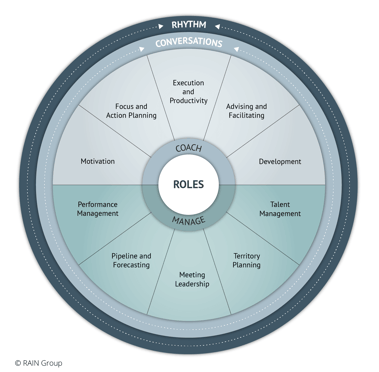
Top-Performing Sellers tend to be supported by highly effective sales managers. Our research reveals that the best sales managers are adept at:
- Providing consistent coaching
- Excelling at 10 sales coaching and management roles
- Leading impactful sales meetings and coaching discussions
Indeed, the best sales managers are more likely to excel at coaching sellers to lead great sales conversations, win sales opportunities, and grow accounts.
Organizations that neglect sales management training, focusing only on seller skills, often find their investments yielding minimal returns. It's crucial to prioritize both in your onboarding.
Action Step
Identify the knowledge, skills, and behaviors your sales teams need to be successful. Download the Top-Performing Seller and Top-Performing Sales Manager models or use whatever competency framework your organization has adopted.
Tailor Learning Journeys
Your onboarding plan should provide a learning path that’s tailored for all sales team members and their roles: sellers, BDRs, account managers, customer success, managers, coaches, etc. It’s how you set everyone up for success.
Year 1 Training Plan [Detailed Example]
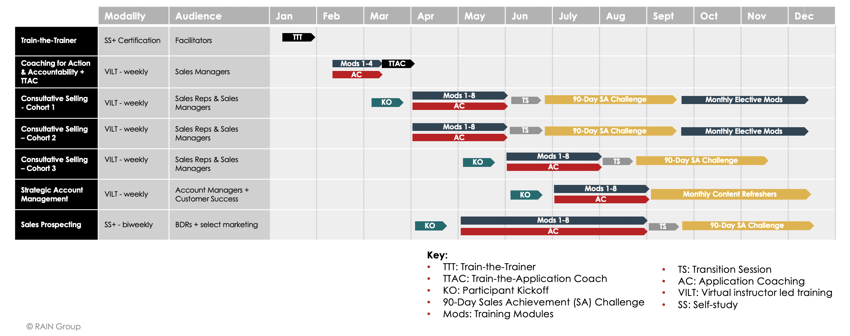
To resonate with participants and make the training impactful, it’s important to target the training curriculum to groups of learners as appropriate—for example, based on role (business dev rep, inside sales rep, outbound sales, field sales, customer service, account manager, sales manager, etc.), product/service, industry, channel, geography, and so on.
While some topics will be relevant across the board, the nuances matter. Tailoring examples, exercises, and tools to your organization and market, as well as specific groups, ensures the training prepares new hires to succeed.
Make It Modular
You don’t want to create an onboarding program from scratch with each new cohort or individual hire. It’s not efficient or effective.
Instead, tap into a training resource library that’s flexible and scalable to meet your learners’ needs now and later. This could be an internally created resource, or one created by a third party.
A modular approach to sales training lends itself to tailored learning journeys, as well as everboarding—that is, going beyond the initial onboarding, to deliver resources for continuous learning as team members develop new skills and grow their capabilities over time.
For instance, RAIN Group clients can provide their sales teams with access to our entire training suite—including learning modules, videos, tools and assets, Train the Trainer and Train the Coach, learning journeys, and implementation support—across topics including sales skills, productivity, management, and coaching areas through our affordable subscription-based RAIN Group Total Access.
This allows for:
- Cohorts to train concurrently
- Different curricula to be assigned by segment (e.g., role, division, geography)
- A variety of modalities including on-site, virtual instructor-led, self-study, and hybrid training
- A scalable and flexible approach to deliver to small groups or large roll outs as needed
Once you have a tailored curriculum and schedule in place, you’re able to hold both sellers and sales managers accountable—sellers for completing the onboarding curriculum and sales managers for facilitating discussions with sellers around key topics.
Minimize Time Out of the Field
How can you minimize your sellers’ time out of the field while preparing them to improve their sales results?
Self-study, also known as independent learning, can do this, but often gets a bad rap. If you’ve ever signed up for an online course and then not followed through with it, you know how this happens.
But there’s a way sales organizations can approach self-study so it actually works. Do these five things:
- Run a cohort kickoff session: Approach self-study in small learning cohorts and host a cohort kickoff to build excitement, set expectations, and create shared accountability around the self-study learning.
- Release self-study modules over time: Release new learning modules weekly, giving learners a specific flow to follow. Modules should include microlearning videos, tips, tools, and knowledge checks.
- Complete application assignments: Assign practical activities that participants are challenged to apply in real sales scenarios and given a date for completion.
- Promote peer review: Pair each participant with an accountability partner to monitor progress, provide feedback, and motivate each other.
- Provide application coaching: Assign experienced coaches to work with small groups to address questions, provide guidance, review assignments, and facilitate discussions on best practices.
Learn how sales enablement can use self-study the right way.
Action Step
Create a training plan with timelines that builds out tailored learned journeys as appropriate for your organization, include goals, applicable programs, coaching, and achievement challenges.
2. Deliver Highly Effective Onboarding
When it comes to delivering the onboarding program, there are five key components to consider:
1. Structured Onboarding with Accountability
When sellers have a clear onboarding process, sales strategy, and method, they’re equipped to excel. As mentioned above, with a well-defined curriculum, sellers and sales managers can be held accountable. This structure, combined with application assignments and regular coaching, ensures sellers feel supported and engaged.
When delivering the onboarding, make sure expectations are set from the get-go. New hires should know exactly what is expected of them over what timeframe with regular progress check-ins and one-on-ones to stay on track. A simple expectations-setting meeting and timeline in their first week can go a long way towards setting the table for success.
2. Modern Training Techniques
Gone are the days when sales onboarding was limited to classroom sessions. Today, flipped classrooms and blended delivery methods, including web-based tools like video, gamification, AI, and digital simulations, make training more engaging and effective.
Consider a hybrid delivery with both in person and remote elements to create an effective onboarding experience that includes:
- Simulations and role plays (used by 66% of organizations with the most effective onboarding)
- Knowledge checks/quizzes (used by 66% of organizations with the most effective onboarding)
- Activities and exercises (used by 64% of organizations with the most effective onboarding)
- Shadowing other sellers or team members (used by 60% of organizations with the most effective onboarding)
3. Reinforced Learning
Despite the demonstrated benefits of reinforcement in sales training, less than half of companies follow up on their initial training. Research shows that consistent reinforcement, especially through engaging videos and microlearning, can lead to a 20% increase in salespeople achieving their quotas2.
The power of spaced repetition and interval reinforcement can't be overstated. For instance, exposing learners to an idea six times with short breaks in between can boost retention rates to over 90%3.
An effective onboarding program will reinforce what the new hires need to know, giving them multiple exposures to the most important topics over time.
4. Practical Application
Learning is most effective when it's applied. Just as you can’t learn to ride a bike by merely watching videos, sellers need to practice their skills. Application assignments, where sellers apply new skills in real-world scenarios and receive feedback, are invaluable. For each new skill, give sellers a practical assignment to complete and share with their coach or manager for feedback.
For example, an application assignment that’s part of a training module on objection handling, might have sellers prepare for an upcoming sales call by:
- Making a note of the possible objections or questions the buyer will have
- Identifying the type of each objection
- Preparing how they’ll respond
Then, prior to the call, sellers review and discuss their response strategy with their coach and receive feedback. This hands-on approach ensures that sellers not only learn but also master the skills they're taught.
5. Ongoing Coaching
A key theme throughout this article is the importance of coaching and we’ll say it again here: be sure to include a regular schedule of coaching for sellers where managers or coaches provide feedback on seller activities (needs discovery calls, proposals, etc.).
Sellers are 63% more likely to be Top Performers when they have an effective manager, effective training, and receive a regular schedule of coaching.
A seller's experience of being invested in and supported, combined with the increased effectiveness of the onboarding process and the faster time to ramp-up, will reduce unwanted turnover.
The goal is to move from learning to immediate on-the-job application, ensuring that onboarding translates into tangible results.
All of this—structured onboarding with accountability, modern training techniques, reinforced learning, practical application, and a regular schedule of coaching—allows organizations to implement effective onboarding that gets new hires to productivity faster.
Action Step
If you're considering hiring a third-party provider to develop your onboarding program, use the Hiring a Sales Training Provider checklist to make sure all the points we covered above are represented. While it's specific to sales training, it generally fits the needs and best practices of most outsourced learning providers. →
3. Enable New Sales Hires to Succeed
In the Enable phase of the onboarding process, you empower your sellers to execute. You accomplish this by providing productivity and execution coaching and embedding the sales method into the organization.
Providing Productivity and Execution Coaching
Combining skill development with productivity and execution coaching is necessary to drive seller success in both the short- and long-term. Too many people (47%) admit to spending significant time on non-value-add activities. It’s important to set the right—productive—tone from the very beginning.
How do you get your new sales hires started on a productive path, so they maximize their time on sales activities that yield the best results?
It starts with your sales managers. Their role is to:
- Motivate sellers to get to, and stay at, the top of their game
- Help sellers define goals and action plans, and guide them to the behaviors that will help them succeed the most
- Work with sellers to use the available tools and resources so sellers execute more consistently and with better results
- Advise sellers on how to win sales
- Guide sellers to develop into top performers
- Hold sellers accountable for their results
This is why you can’t afford to neglect training your sales managers—they must be prepared for the important role they play to onboard and support new hires.
Training and coaching your sales managers will help them understand the skills their sellers need, as well as improve their own coaching abilities. They’ll be equipped to observe sellers, give feedback, encourage the use of skills, and hold sellers accountable.
90-Day Sales Challenges: Boosting Sales and Getting Results
There’s a strong correlation between how sellers work and the results they get.
When sellers adopt productive habits, they not only hit tough sales targets but also score higher win rates and better pricing.
For sales onboarding to be most effective, sales managers need to work with sellers to help them apply productive habits in a highly structured way. When they do, sellers are more likely to know which activities to spend time on and take actions that produce results.
Here’s how we do it at RAIN Group. First, we teach sales managers how to get their teams motivated, focused, and executing. Then, for 90 days, we guide the managers to roll out a 90-Day Sales Achievement Challenge with their teams.
The challenge is split into three parts:
- Launch: Get sellers to use new sales skills and habits straight away.
- Amplification: Challenge sellers to push their skills and productivity to the max.
- Embedding: Make sure these new behaviors stick for good. It takes a solid 90 days to make it happen.
Sales managers are your most valuable players, making sure sellers learn, use, and focus on the right stuff to get the best results.
Embedding the Sales Method into the Organization
Providing strong training on the organization’s sales process and methodology is the #1 key driver of effective onboarding. This is another reason why it’s important to make sure your managers are exposed to training on the same topics as sellers: sellers should be getting advice and coaching from their managers that’s consistent with your sales method.
This doesn’t have to be an onerous process. You can minimize disruption and maximize your investment by leveraging onboarding and ongoing sales training across the entire sales organization.
One way to do this is by tapping into a comprehensive sales resource such as RAIN Group’s Total Access subscription, which gives users affordable access to a complete library of training resources, combined with performance support for strong implementation. As a client recently told us, “It’s transformative. On-demand learning with trusted and vetted content that would take us years to build on our own.”
This approach gives access to top-notch sales content and a strong partnership. It empowers internal sales enablement teams, no matter the size, to launch and maintain strong onboarding and engaging continuous learning for sales teams.
Action Step
Answer these questions:
- How will you provide productivity and execution coaching?
- How will you train sales managers on the same topics as sellers?
- How will you help sales managers improve coaching abilities?
- Will you deliver a 90 Day Sales Challenge or similar?
- How will you embed the sales method into the organization?
Measure, Analyze, and Improve
Measurement is the backbone of continuous improvement, but it’s another element that’s often overlooked in sales onboarding.
Start by focusing on learner engagement metrics like attendance and satisfaction. Then, go back to the metrics you defined earlier in the Craft phase. As the learning program progresses, track lead indicators (e.g., outbound activity, meetings set, presentations delivered, demos conducted, account plans completed). Then, monitor lag indicators (e.g., revenue, yield, average sale, time to productivity) to gauge the overall impact.
Enabling a sales team goes beyond training. It's about creating a culture of continuous learning, embedding an effective sales method, holding everyone accountable, and continuous improvement.
Final Action Step
Once you’ve completed the actions outlined throughout this article, pull all your materials together and review them through the lens of your organization’s Sales Onboarding Blueprint.
As you create your sales onboarding plan, ask yourself: will the sales onboarding process move the organization from the current state to the desired new reality? Will the sales team get the training, support, and coaching they need to deliver results?
Review your sales onboarding plan against the Designing a Highly Effective Sales Onboarding Program Checklist to ensure it's as successful as possible.
1 A regression of onboarding effectiveness with onboarding characteristics yields 4 statistically significant explanatory variables with an adjusted R-squared of 45.9%. The Relative Importance Analysis tells us the relative importance of predictor variables (onboarding characteristics) on the outcome variable (effectiveness). In other words, the 4 onboarding characteristics here are key drivers (or predictive factors) of effective onboarding.
2 Peter Ostrow, It’s a Marathon, Not a Sprint: Best-In- Class B2B Sales Training for an Ever-Changing Market (Aberdeen, 2015).
3 Hermann Ebbinghaus, Memory: A Contribution to Experimental Psychology (Teachers College, 1885).






